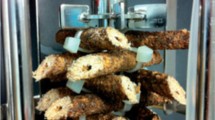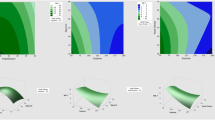Abstract
Menaquinone-7 (MK-7), a subtype of vitamin K, has received a significant attention due to its effect on improving bone and cardiovascular health. Current fermentation strategies, which involve static fermentation without aeration or agitation, are associated with low productivity and scale-up issues and hardly justify the commercial production needs of this vitamin. Previous studies indicate that static fermentation is associated with pellicle and biofilm formations, which are critical for MK-7 secretion while posing significant operational issues. Therefore, the present study is undertaken to evaluate the possibility of using a biofilm reactor as a new strategy for MK-7 fermentation. Bacillus species, namely, Bacillus subtilis natto, Bacillus licheniformis, and Bacillus amyloliquifaciens as well as plastic composite, supports (PCS) were investigated in terms of MK-7 production and biofilm formation. Results show the possibility of using a biofilm reactor for MK-7 biosynthesis. Bacillus subtilis natto and soybean flour yeast extract PCS in glucose medium were found as the most potent combination for production of MK-7 as high as 35.5 mg/L, which includes both intracellular and extracellular MK-7.







Similar content being viewed by others
References
Dam H (1935) The Antihaemorrhagic vitamin of the chick: occurrence and chemical nature. Nature 135:652–653
Binkley SB, Maccorquodale DW, Thayer A, Doisy EA (1939) The isolation of vitamin K1. J Biol Chem 130:219–234
Widhalm JR, Ducluzeau A-L, Buller NE, Elowsky CG, Olsen LJ, Basset GJC (2012) Phylloquinone (vitamin K(1)) biosynthesis in plants: two peroxisomal thioesterases of Lactobacillales origin hydrolyze 1,4-dihydroxy-2-naphthoyl-CoA. Plant J 71:205–215. doi:10.1111/j.1365-313X.2012.04972.x
Davidson RT, Foley AL, Engelke JA, Suttie JW (1998) Conversion of dietary phylloquinone to tissue Menaquinone-4 in rats is not dependent on Gut bacteria. J Nutr 128:220–223
Bentley R, Meganathan R (1982) Biosynthesis of vitamin K (Menaquinone) in bacteria. Microbiol Rev 46:241–280
Berenjian A, Mahanama R, Kavanagh J, Dehghani F (2015) Vitamin K series: current status and future prospects. Crit Rev Biotechnol 35:199–208. doi:10.3109/07388551.2013.832142
Schurgers LJ, Teunissen KJF, Hamulyák K, Knapen MHJ, Vik H, Vermeer C (2007) Vitamin K-containing dietary supplements: comparison of synthetic vitamin K1 and natto-derived Menaquinone-7. Blood 109:3279–3283. doi:10.1182/blood-2006-08-040709
Howard LM, Payne AG (2006) Health benefits of vitamin K2: a revolutionary natural treatment for heart disease and bone Loss, 1st edn. Basic Health Publications Inc, Laguna Beach
Yamaguchi M (2006) Regulatory mechanism of food factors in bone metabolism and prevention of osteoporosis. Yakugaku Zasshi 126:1117–1137. doi:10.1248/yakushi.126.1117
Gast GCM, de Roos NM, Sluijs I, Bots ML, Beulens JWJ, Geleijnse JM, Witteman JC, Grobbee DE, Peeters PHM, van der Schouw YT (2009) A high Menaquinone intake reduces the incidence of coronary heart disease. Nutr Metab Cardiovasc Dis 19:504–510. doi:10.1016/j.numecd.2008.10.004
Geleijnse JM, Vermeer C, Grobbee DE, Schurgers LJ, Knapen MHJ, van der Meer IM, Hofman A, Witteman JCM (2004) Dietary intake of menaquinone is associated with a reduced risk of coronary heart disease: the Rotterdam Study. J Nutr 134:3100–3105
Survase AS, Bajaj BI, Singhal SR (2015) Biotechnological production of vitamins biotechnological production of vitamins. Food Technol Biotechnol 44:381–396
Sato T, Yamada Y, Ohtani Y, Mitsui N, Murasawa H, Araki S (2001) Production of menaquinone (vitamin K2)-7 by Bacillus subtilis. J Biosci Bioeng 91:16–20
Berenjian A, Chan NL-C, Mahanama R, Talbot A, Regtop H, Kavanagh J, Dehghani F (2013) Effect of biofilm formation by Bacillus subtilis natto on Menaquinone-7 biosynthesis. Mol Biotechnol 54:371–378. doi:10.1007/s12033-012-9576-x
Mahdinia E, Demirci A, Berenjian A (2017) Production and application of menaquinone-7 (vitamin K2): a new perspective. World J Microbiol Biotechnol 33:2. doi:10.1007/s11274-016-2169-2
Ikeda H, Doi Y (1990) A vitamin-K2-binding factor secreted from Bacillus subtilis. Eur J Biochem 192:219–224. doi:10.1111/j.1432-1033.1990.tb19218.x
Berenjian A, Mahanama R, Talbot A, Regtop H, Kavanagh J, Dehghani F (2012) Advances in Menaquinone-7 production by Bacillus subtilis natto: fed-batch glycerol addition. Am J Biochem Biotechnol 8:105–110. doi:10.3844/ajbbsp.2012.105.110
Ercan D, Demirci A (2013) Current and future trends for biofilm reactors for fermentation processes. Crit Rev Biotechnol 8551:1–14. doi:10.3109/07388551.2013.793170
Pongtharangkul T, Demirci A (2006) Effects of fed-batch fermentation and pH profiles on nisin production in suspended-cell and biofilm reactors. Appl Microbiol Biotechnol 73:73–79. doi:10.1007/s00253-006-0459-6
Ercan D, Demirci A (2013) Production of human lysozyme in biofilm reactor and optimization of growth parameters of Kluyveromyces lactis K7. Appl Microbiol Biotechnol 97:6211–6221. doi:10.1007/s00253-013-4944-4
Cheng KC, Demirci A, Catchmark JM (2010) Advances in biofilm reactors for production of value-added products. Appl Microbiol Biotechnol 87:445–456. doi:10.1007/s00253-010-2622-3
Khiyami MA, Pometto ALI, Kennedy WJ (2006) Ligninolytic enzyme production by Phanerochaete chrysosporium in plastic composite support biofilm stirred tank bioreactors. J Agric Food Chem 54:1693–1698
Berenjian A, Mahanama R, Talbot A, Biffin R, Regtop H, Valtchev P, Kavanagh J, Dehghani F (2011) Efficient media for high Menaquinone-7 production: response surface methodology approach. N Biotechnol 28:665–672. doi:10.1016/j.nbt.2011.07.007
Ho KG, Pometto III AL, Hinz PN, Dickson JS, Demirci A (1997) Ingredient selection for plastic composite supports for l-(1)-lactic acid biofilm fermentation by Lactobacillus casei subsp. rhamnosus. Appl Environ Microbiol 63:2516–2523
Cheng K-C, Demirci A, Catchmark JM (2010) Effects of plastic composite support and pH profiles on pullulan production in a biofilm reactor. Appl Microbiol Biotechnol 86:853–861. doi:10.1007/s00253-009-2332-x
Rahimi M, Zhu L, Kowalski KL, Zhu X, Gorski CA, Hickner MA, Logan BE (2017) Improved electrical power production of thermally regenerative batteries using a poly(phenylene oxide) based anion exchange membrane. J Power Sources 342:956–963. doi:10.1016/j.jpowsour.2017.01.003
Rahimi M, Schoener Z, Zhu X, Zhang F, Gorski CA, Logan BE (2017) Removal of copper from water using a thermally regenerative electrodeposition battery. J Hazard Mater 322:551–556. doi:10.1016/j.jhazmat.2016.10.022
Ahmadian MT, Firoozbakhsh K, Hasanian M (2011) Simulation of red blood cell motion in microvessels using modified moving particle semi-implicit method. Sci Iran 19:113–118. doi:10.1016/j.scient.2011.12.007
Berenjian A, Mahanama R, Talbot A, Biffin R, Regtop H, Kavanagh J (2011) The effect of amino-acids and glycerol addition on MK-7 production. Proc World Congr Eng Comput Sci 11:19–21
Demirci A, Pongtharangkul T, Pometto III AL (2007) Applications of biofilm reactors for production of value-added products by microbial fermentation. Blackwell Publishing and The Institude of Food Technologists, Iowa
Acknowledgements
This project was partly funded by the Pennsylvania Agricultural Experiment Station. The authors thank the Statistical Consulting Center at Pennsylvania State University for assisting data processing.
Author information
Authors and Affiliations
Corresponding author
Ethics declarations
Conflict of interest
The authors declare that they have no conflict of interest.
Rights and permissions
About this article
Cite this article
Mahdinia, E., Demirci, A. & Berenjian, A. Strain and plastic composite support (PCS) selection for vitamin K (Menaquinone-7) production in biofilm reactors. Bioprocess Biosyst Eng 40, 1507–1517 (2017). https://doi.org/10.1007/s00449-017-1807-x
Received:
Accepted:
Published:
Issue Date:
DOI: https://doi.org/10.1007/s00449-017-1807-x




